#kepler-10b
Explore tagged Tumblr posts
Text

✧ Kepler-10B ✧ I'm starting a new segment on my socials called Midas Mondays where whatever i touch gets turned into an attractive person for better or for worse /J first up was kepler-10b and i just took it as an opportunity to make a starliian bc why not
#midasmondays#artwork#digital art#fantasy art#artists on tumblr#starliian race#starliians#celestial oc#celestial#phoenix#avian#avian art#bird person#kepler 10b#art
7 notes
·
View notes
Text
The smallest planet we have discovered is called Kepler-10b.
4 notes
·
View notes
Text
@teaganmyrick
Kepler-10b is the most interesting to me. The lava ocean was a great reference for an animation I did a while back. Plus the name ‘A Scorched World’ is pretty wicked.
It’s a pretty wicked cool planet. Imagine how cool it’d be to actually be able to explore something like that? If only.
Do you like, animate stuff then? Or uh-- are you an animator?

79 notes
·
View notes
Text
The Kepler space telescope has shown us our galaxy is teeming with planets — and other surprises

The Kepler space telescope has taught us there are so many planets out there, they outnumber even the stars. Here is a sample of these wondrous, weird and unexpected worlds (and other spectacular objects in space) that Kepler has spotted with its “eye” opened to the heavens.
Kepler has found that double sunsets really do exist.

Yes, Star Wars fans, the double sunset on Tatooine could really exist. Kepler discovered the first known planet around a double-star system, though Kepler-16b is probably a gas giant without a solid surface.
Kepler has gotten us closer to finding planets like Earth.
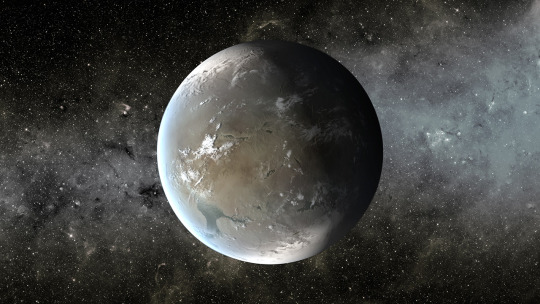
Nope. Kepler hasn’t found Earth 2.0, and that wasn’t the job it set out to do. But in its survey of hundreds of thousands of stars, Kepler found planets near in size to Earth orbiting at a distance where liquid water could pool on the surface. One of them, Kepler-62f, is about 40 percent bigger than Earth and is likely rocky. Is there life on any of them? We still have a lot more to learn.
This sizzling world is so hot iron would melt!
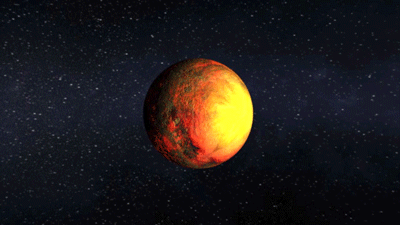
One of Kepler’s early discoveries was the small, scorched world of Kepler-10b. With a year that lasts less than an Earth day and density high enough to imply it’s probably made of iron and rock, this “lava world” gave us the first solid evidence of a rocky planet outside our solar system.
If it’s not an alien megastructure, what is this oddly fluctuating star?

When Kepler detected the oddly fluctuating light from “Tabby’s Star,” the internet lit up with speculation of an alien megastructure. Astronomers have concluded it’s probably an orbiting dust cloud.
Kepler caught this dead star cannibalizing its planet.
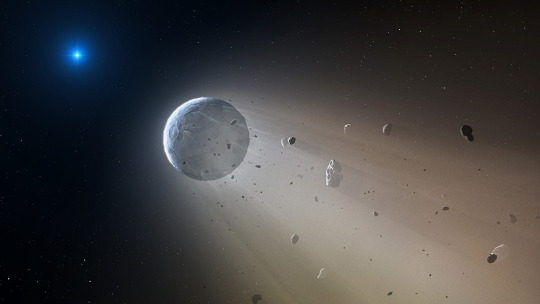
What happens when a solar system dies? Kepler discovered a white dwarf, the compact corpse of a star in the process of vaporizing a planet.
These Kepler planets are more than twice the age of our Sun!
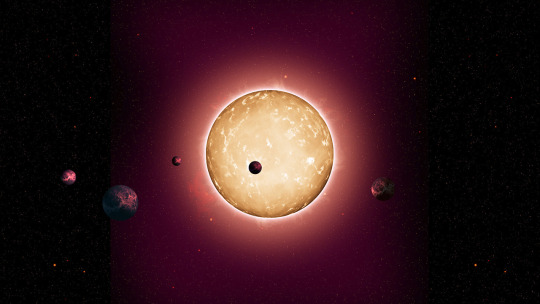
The five small planets in Kepler-444 were born 11 billion years ago when our galaxy was in its youth. Imagine what these ancient planets look like after all that time?
Kepler found a supernova exploding at breakneck speed.
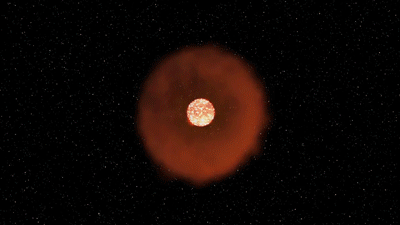
This premier planet hunter has also been watching stars explode. Kepler recorded a sped-up version of a supernova called a “fast-evolving luminescent transit” that reached its peak brightness at breakneck speed. It was caused by a star spewing out a dense shell of gas that lit up when hit with the shockwave from the blast.
* All images are artist illustrations.
Make sure to follow us on Tumblr for your regular dose of space: http://nasa.tumblr.com
16K notes
·
View notes
Note
School of Athens and The scream for the masterpieces asks thing!
School of Athens: do you know any unusual facts?
Yes. I will list a few. Did you know that Kepler’s third law of planetary motion is ( 4pi^2/ G(M1+M2))a^3? Did you know that Dimidium/ 51 Pegasi B was the first exoplanet discovered orbiting a star (discovered 1995)? Did you know that Kepler-10b orbits a star between the constellations Cygnus and Lyra? Did you know that little kid Queen Elizabeth loved Katherine Howard? Did you know that Katherine Howard gave Elizabeth the place of honor of the place nearest to her at social events?
The scream: do you have any unusual fears?
Getting stabbed in the back and breaking my nose. Not really like fears, but things that I think will happen. Most of my fears are very generic.
Thank you so much for the ask!! 💜💜💜
#thank you!!#💜💜💜#am-a-disappointment#yes I know Im a space and Katherine Howard nerd#im actually just an all around nerd
3 notes
·
View notes
Photo
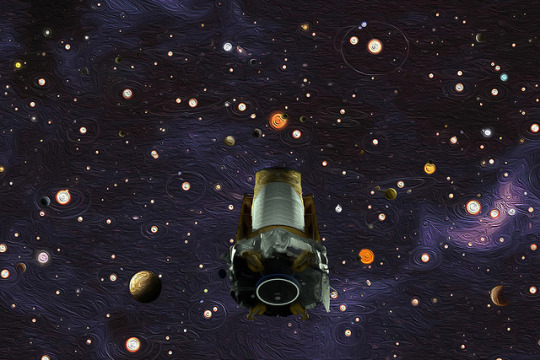
Его дозор окончен .
С пятой попытки
Немецкий астроном, математик и физик Иоганн Кеплер и мечтать не мог о том, чтобы изучать миры за пределами Солнечной системы. Он жил во времена, когда еще не было достоверно доказано, что Земля — не центр мироздания. Ученые колебались между геоцентрической моделью Птолемея и гелиоцентрической моделью Коперника. Сам Кеплер немало способствовал утверждению последней, выяснив, что планеты вращаются не по круглым, как считалось ранее, а по эллиптическим орбитам и замедляют движение, удаляясь от Солнца. Кроме того, сделав ряд открытий в оптике, Кеплер в 1611 году усовершенствовал телескоп Галилея и увеличил его поле зрения, заменив рассеивающую линзу собирающей. За эти заслуги четыре столетия спустя, когда скромное место Земли во Вселенной было многократно доказано, именем немецкого ученого был назван телескоп для поиска планет, вращающихся вокруг собственных звезд, бесконечно далеких от нас.
В 1983 году планетолог NASA Уильям Боруки начал разработку идеи о поиске планет, похожих на Землю, за пределами Солнечной системы. В основе идеи были периодические спады видимого блеска наблюдаемых телескопами звезд. Эти спады выглядели как аккуратные «провалы» на соответствующих графиках светимости. Гипотеза Боруки была в том, что эти «провалы» вызваны прохождением планеты на фоне звездного диска. Чем глубже «провал» — тем больше планета. Техника поиска планет таким способом получила название транзитной фотометрии, а Боруки начал работу над высокоточными детекторами света – фотометрами.
Как «Кеплер» «смотрит» на мирNASA/Ames/J. Jenkins
Четыре раза ученый предлагал NASA проект по поиску дальних планет с помощью фотометров, но только пятая попытка увенчалась успехом – в 2001 году космическое агентство одобрило миссию Kepler для поиска ��вездных систем с близкими по размерам к Земле планетами в обитаемой зоне. То есть, таких, где может существовать жидкая вода — и, возможно, жизнь.
6 марта 2009 года телескоп «Кеплер», оснащенный сверхчувствительным фотометром и цифровыми камерами был выведен на гелиоцентрическую орбиту. Спустя месяц он начал наблюдения, нацелившись на участок звездного неба в созвездиях Лиры и Лебедя. В поле его зрения находилось 4,5 миллиона звезд, из которых он почти непрерывно наблюдал 170 000, фиксируя изменения в их свечении. Таким образом Кеплер стал первой миссией NASA по поиску землеподобных планет у далеких звезд.
Уже через год были объявлены первые результаты – «Кеплер» обнаружил пять экзопланет, которые оказались газовыми гигантами наподобие Юпитера и получили название Kepler-4b, -5b, -6b, -7b и -8b. С тех пор почти все открытые телескопом планеты назывались в его честь, и, соответственно, в честь немецкого исследователя.
Основная программа была рассчитана на 3,5 года. 12 мая 2013 года телескоп вышел из строя. Из-за отказа двух гироскопов орбитальная обсерватория потеряла возможность разворачиваться в нужном направлении и поддерживать ориентацию с высокой точностью после чего наблюдения фактически прекратились. Команда телескопа начала искать выход из положения и нашла – теперь поле обзора телескопа меняли каждые три месяца, поворачивая телескоп при помощи двигателей. Таким образом в мае 2014 года миссия «Кеплера» под названием К2 возобновилась, а количество наблюдаемых звезд возросло до 500 000. Телескоп прослужил вдвое дольше и за все время своего существования преподнес ученым множество открытий.
[-block-]
В поисках второй Земли
До «Кеплера» было неясно, настолько ли уникальна Солнечная система, располагающая восемью планетами. Наблюдения космического телескопа показали, что Млечный путь планетами буквально кишит. И среди них оказалось множество интересных экземпляров с непохожими судьбами.
Так, в 200 све��овых годах от Земли «Кеплер» обнаружил планету Kepler-16b в системе двойной звезды. С нее можно было бы увидеть прекрасные двойные закаты, как на планете Татуин из киноэпопеи «Звездные войны», но, к сожалению, планета, по-видимому, представляет собой холодный газовый гигант размером с Сатурн вне обитаемой зоны и без какой-либо твердой поверхности, с которой кто-либо мог бы любоваться сразу двумя звездами. Зато наблюдения «Кеплера» подтвердили само существование подобного класса планетных систем.
Художественное изображение того, как выглядит Kepler-16b, что обращается сразу вокруг двух звездNASA/JPL-Caltech/R. Hurt
Первую каменную планету телескоп обнаружил в 2011 году – ее назвали Kepler-10b. Она расположена в 20 раз ближе к своей звезде Kepler-10, чем Меркурий к Солнцу, а год на ней длится менее одного земного дня. Планета в 4,6 раз тяжелее Земли и имеет плотность вещества 8.8 граммов на кубический сантиметр, так что вероятно, состоит из железа. Но поскольку на планете очень жарко, железо, вероятнее всего, находится в жидком состоянии. Маленький мир сплошной раскаленной лавы.
В 2015 году Кеплер разглядел в созвездии Девы белый карлик – мертвую звезду, убивающую — точнее, испаряющую — свою планету. Такой вывод ученые сделали по странному графику светимости.
Художественное изображение того, как белый карлик WD 1145+17 испаряет тело на своей орбитеCfA/Mark A. Garlick
Обычные планеты, проходя мимо своей звезды и снижая ее светимость, образуют на графике хорошо видимый провал с двумя одинаково отвесными «берегами». Здесь же один «берег» был ассиметричным, гораздо более пологим и удлиненным, что указывало на наличие у планеты хвоста наподобие кометного. Кроме того, белые карлики из-за высокой гравитации имеют довольно однородный состав поверхности – там только легкие элементы вроде гелия и водорода. Но ранее ученые обнаруживали в оболочках этих мертвых звезд и более тяжелые элементы — кальций, кремний и железо. Два этих факта и натолкнули ученых на мысль, что белые карлики могут испарять планеты, пережившие их взрыв, и засасывать с их поверхности тяжелые элементы, которые и «загрязняют» звездную поверхность.
Красная кривая — спад блеска звезды пр�� затмении его обычной планетой. Синяя, построенная по данным «Кеплера» (черные точки) соответствует планете, за которой тянется размазанный хвост из испаренной материиИзображение: NASA.
В том же году «Кеплер» нашел в созвездии Лиры в 117 световых годах от Земли пять маленьких и очень древних планет в системе Kepler-444, красного карлика. Размерами они не превышают Венеру и все вращаются очень близко к своей звезде, совершая полный оборот менее чем за 10 земных дней. Сформировалась эта система 11,2 миллиардов лет назад – раньше, чем большинство звезд в млечном пути.
Этим же телескопом открыта система Kepler-90, похожая на Солнечную систему в том смысле, что в ней тоже есть маленькие каменные планеты близко от звезды и газовые гиганты далеко от нее, что наталкивает на мысль об одних и тех же законах формирования подобных систем. Правда, и эта система в целом много меньше нашей: все планеты вращаются в пределах орбиты Венеры.
Сравнение системы Kepler-90 с Солнечной. При этом звезда Kepler-90 даже ярче Солнца, так что на всех этих планетах должно быть очень жаркоИллюстрация: NASA/Ames Research Center/Wendy Stenzel
Конечно, заветная мечта астрономов – обнаружить Землю-2. Пока эти попытки не увенчались успехом, но кое-какие результаты достигнуты. В 2014 году «Кеплер» впервые обнаружил планету размерами не более чем на 10% больше Земли и расположенную в обитаемой зоне звезды. Правда, ни ее масса, ни состав, ни плотность вещества неизвестны, а сама она находится в 500 световых годах от Земли в созвездии Лебедя.
Всего к 2017 году «Кеплер» обнаружил 219 похожих на Землю планет. Из них десять могут быть даже обитаемыми — во всяком случае они находятся в зоне обитаемости и имеют сопоставимые с Землей размеры. Но вопрос наличия на них воды остается открытым, что только подстегивает энтузиазм искателей экзопланет.
[-block-]
Множество миров
В отличие от земных телескопов, которые могут работать только по ночам и когда небо чистое, «Кеплер» дал ученым возможность непрерывно наблюдать за звездами месяцами. За почти 10 лет своей работы «Кеплер» открыл более 2500 экзопланет, посмотрел на 530 506 звезд, зафиксировал 61 вспышку сверхновой, и по этим открытиям написано 2946 научных работ. Последнее число явно не окончательно - новые статьи выходят едва ли не ежедневно.
Самый недавний анализ открытий Кеплера показал, что 20-50% звезд, видимых на небе, вероятнее всего имеют около себя небольшие каменные планеты, близкие по размеру Земле и расположенные в обитаемой зоне у звезд — там где может существовать жидкая вода.
«Он не только показал нам, как много планет может быть в космосе – он подстегнул развитие целого нового и трудного поля для исследований, которое теперь штурмует научное сообщество. Его открытия пролили новый свет на наше место во Вселенной и бросили свет на дразнящие загадки звезд», — говорит Томас Зурбучен, помощник администратора Научного управления NASA в Вашингтоне.
Задумывая миссию 35 лет назад, ученые не знали о существовании ни одной планеты за пределами Солнечной системы. «Теперь мы знаем, что планеты повсюду. Кеплер проложил нам новый курс, полный надежд для будущих поколений исследователей галактики», — говорит Уильям Боруки.
Перед тем как оставить «Кеплер» блуждать в космосе, ученые загрузили с него последнюю порцию данных. Они послужат хорошей основой для следующих наблюдений: в апреле этого года на свой пост вышел новый телескоп для поиска экзопланет — Transiting Exoplanet Survey Satellite (TESS). Программа его наблюдений за 200 тысячами ближайшими к Земле звёздами основана в том числе на данных «Кеплера».
https://ift.tt/2qhF634
1 note
·
View note
Text
UNIVERSE'S: MOST STRANGEST PLANETS
UNIVERSE’S: MOST STRANGEST PLANETS
1. PLANET TrES-2b: Pitch Black planet, Absorbs 99.3% of its sun’s light. 2. PLANET GLIESE 436B: Continuously evaporating at super-high temperature and it also has a comet-like tail. 3. PLANET KEPLER-10B: Surface covered with Lava Oceans. 4. PLANET METHUSELAH: Oldest known planet to humans. 13 billion years old. It can also have extraterrestrial life. 5. PLANET HD 106906: It’s a mystery…

View On WordPress
0 notes
Text
the weird ones

TrES 2b is the darkest planet known. The planet is darker than coal and reflects less than 1% of light. The only color seen is from the heat of the planet making it glow red.

Kepler-16b is an extrasolar planet. It the first confirmed case of a planet orbiting binary stars.

Wasp-12b is being consumed by its star. It orbits very close to its parent star with a temperature of 2,800 degrees Fahrenheit.

J1407-B has rings 200 times as large as Saturn’s. If this planet replaced Saturn in our system, the rings would be visible from Earth.

TrES 4 is one of the largest known planets with a diameter of 79,917 miles. It is so large that it theoretically should not exist with current understanding of planets.

Cancri e is tidally locked with its star which means it does not rotate itself. It is believed that the surface of the planet is made of water in a super critical state where it is liquid and gas at the same time.

CoRoT-7b is also tidally locked to the parent star, rain rocks, and is believed to be the core of a gas giant. The surface is also very hellish with temperatures estimated around 4,000 degrees Fahrenheit.

Kepler-10b is the smallest known exoplanet that is believed to have an ocean of lava on the surface.

Planet Gliese 436 b also known as the planet of burning ice. The planet is constantly on fire because of the close proximity to its star but the ice doesn’t melt because the planet’s gravity prevents the water from evaporating.
Animation
Images
1 note
·
View note
Note
Top 5 planets
1. Jupiter2. Saturn3. Kepler-10b4. Pegasi b 5. Kepler-11f
11 notes
·
View notes
Text
Are Star Wars Planets Real?
NASA - Kepler Space Telescope patch. May 4, 2017 Illustration of an Earth-Sized 'Tatooine' Planet
With two suns in its sky, Luke Skywalker's home planet Tatooine in "Star Wars" looks like a parched, sandy desert world. In real life, thanks to observatories such as NASA's Kepler space telescope, we know that two-star systems can indeed support planets, although planets discovered so far around double-star systems are large and gaseous. Scientists wondered: If an Earth-size planet were orbiting two suns, could it support life? It turns out, such a planet could be quite hospitable if located at the right distance from its two stars, and wouldn't necessarily even have deserts. In a particular range of distances from two sun-like host stars, a planet covered in water would remain habitable and retain its water for a long time, according to an April 6, 2017 study in the journal Nature Communications.
Kepler Space Telescope or K2
This illustration shows a hypothetical planet covered in water around the binary star system of Kepler-35A and B. In reality, the stellar pair Kepler-35A and B host a planet called Kepler-35b, a giant planet about eight times the size of Earth, with an orbit of 131.5 Earth days. For their study, researchers neglected the gravitational influence of this planet and added a hypothetical water-covered, Earth-size planet around the Kepler-35 A and B stars. They examined how this planet’s climate would behave as it orbited the host stars with periods between 341 and 380 days. Planets With Two Suns
From Luke Skywalker’s home world Tatooine, you can stand in the orange glow of a double sunset. The same could said for Kepler-16b, a cold gas giant roughly the size of Saturn, that orbits two stars. Kepler-16b was the Kepler telescopes’s first discovery of a planet in a “circumbinary” orbit (that is, circling both stars, as opposed to just one, in a double star system).
The best part is that Tatooine aka Kepler-16b was just the first. It has family. A LOT of family. Half the stars in our galaxy are pairs, rather than single stars like our sun. If every star has at least one planet, that’s billions of worlds with two suns. Billions! Maybe waiting for life to be found on them. Desert Worlds
Mars is a cold desert planet in our solar system, and we have plenty of examples of scorching hot planets in our galaxy (like Kepler-10b), which orbits its star in less than a day)! Scientists think that if there are other habitable planets in the galaxy, they’re more likely to be desert planets than ocean worlds. That’s because ocean worlds freeze when they’re too far from their star, or boil off their water if they’re too close, potentially making them unlivable. Perhaps, it’s not so weird that both Luke Skywalker and Rey grew up on planets that look a lot alike. Ice Planets
An icy super-Earth named OGLE-200-BLG-390Lb reminded scientists so much of the frozen Rebel base they nicknamed it “Hoth,” after its frozen temperature of minus 364 degrees Fahrenheit.
Another Hoth-like planet was discovered last month; an Earth-mass icy world orbiting its star at the same distance as Earth orbits the sun. But its star is so faint, the surface of OGLE-2016-BLG-1195Lb is probably colder than Pluto. Forest worlds
Both the forest moon of Endor and Takodana, the home of Han Solo’s favorite cantina in “Force Awakens,” are green like our home planet. But astrobiologists think that plant life on other worlds could be red, black, or even rainbow-colored! In February 2017, the Spitzer Space Telescope discovered seven Earth-sized planets in the same system, orbiting the tiny red star TRAPPIST-1.
TRAPPIST-1 system
The light from a red star, also known as an M dwarf, is dim and mostly in the infrared spectrum (as opposed to the visible spectrum we see with our sun). And that could mean plants with wildly different colors than what we’re used to seeing on Earth. Or, it could mean animals that see in the near-infrared. "You don’t need to visit a galaxy far, far away to find wondrous worlds. Just visit this one … there’s plenty to see." More: Earth-Sized 'Tatooine' Planets Could Be Habitable: https://www.nasa.gov/feature/jpl/earth-sized-tatooine-planets-could-be-habitable Related article: Ultracool Dwarf and the Seven Planets http://orbiterchspacenews.blogspot.ch/2017/02/ultracool-dwarf-and-seven-planets.html Related links: Exoplanets: https://www.nasa.gov/content/the-search-for-life NASA's Kepler space telescope: https://www.nasa.gov/mission_pages/kepler/main/index.html Images, Animations, Text, Credits: NASA/Sarah Loff/JPL-Caltech. Greetings, Orbiter.ch Full article
66 notes
·
View notes
Text
The first rocky planet found outside of our Solar System was Kepler-10b.
2 notes
·
View notes
Text
El telescopio espacial Kepler se apaga
New Post has been published on https://www.ctvsatelital.net/el-telescopio-espacial-kepler-se-apaga/
El telescopio espacial Kepler se apaga
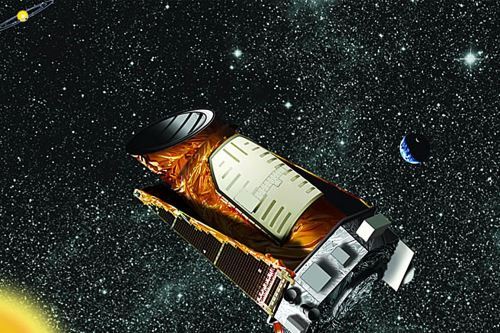
01:32 | Washington, oct. 31.
El Telescopio Espacial Kepler terminó su misión después de nueve años en órbita alrededor del Sol y el descubrimiento de más de 2.600 planetas fuera de nuestro Sistema Solar, anunció la NASA el martes.
Imaginado hace 35 años, en un momento en que no se conocía ningún planeta fuera del Sistema Solar, Kepler tenía como cometido descubrir planetas similares a la Tierra, es decir, de tamaño comparable, rocosos y no gaseosos, y a una distancia ni demasiado cerca ni demasiado lejos de su estrella.
Es la distancia a la que el agua líquida podría, como en la Tierra, estar presente en la superficie, y por lo tanto susceptible de albergar vida.

El telescopio apuntaba a dos constelaciones de la Vía Láctea, la Cygnus y la Lyre, con millones de estrellas en su objetivo y en una resolución extraordinaria para el momento de su concepción.
Su lente era tan sensible que podía detectar la más leve caída en la intensidad de la luz causada por el paso de un planeta frente a su estrella.
En enero de 2010 descubrió los primeros cinco planetas, llamados Kepler-4b, 5b, etc. Pero resultaron ser gaseosos. El primer planeta rocoso se anunció en enero de 2011, el Kepler-10b.
Este está tan cerca de su estrella que una de sus caras probablemente se está derritiendo, convertido en un mundo de lava.
El primer planeta habitable es el número 22b, que podría contener agua líquida. Y en 2014, finalmente, el primer primo real de la Tierra, número 186f, a 580 años luz.
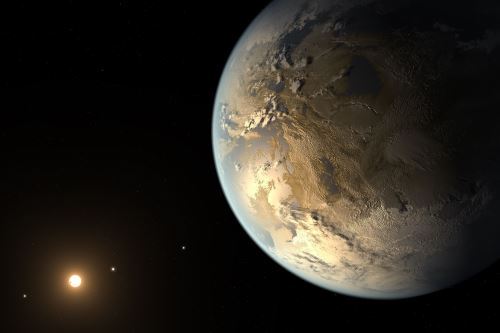
Cientos de descubrimientos siguieron revolucionando nuestro conocimiento de la galaxia, confirmando que la Tierra no es, en última instancia, una excepción galáctica.
Gracias a Kepler, también sabemos que hay más planetas que estrellas en la Vía Láctea. La mayoría tiene un tamaño entre el de la Tierra y Neptuno.
De acuerdo con las observaciones de Kepler, los astrónomos ahora estiman que entre 20% y 50% de las estrellas visibles desde la Tierra en la noche probablemente tengan pequeñas Tierras en sus órbitas a una distancia donde los lagos y los océanos pueden en teoría formarse.
El telescopio también ha hecho extraños descubrimientos, como los sistemas en los que hasta ocho planetas se agolpan en una órbita compacta alrededor de su estrella.
O el planeta Kepler-16b, que gira alrededor de dos estrellas y donde, como en Tatooine, un planeta ficticio de Star Wars, los habitantes podrían asistir a una doble puesta de sol… si no fuera gaseoso.
– Final anunciado –
Como ocurre cuando fallece un importante científico, surgieron de inmediato tributos a Kepler.
“No solo nos mostró cuántos planetas podrían existir en el espacio, sino que también abrió un campo de investigación completamente nuevo y serio que tomó por asalto a la comunidad científica”, dijo Thomas Zurbuchen, director de la división de Investigación Científica de la NASA.
Y como sucede con algunas muertes, la de Kepler no fue realmente una sorpresa. En 2013, los problemas mecánicos precipitaron el final de la misión original del telescopio, que inicialmente solo debía durar tres años y medio.
Pero los ingenieros de la NASA encontraron un sistema para continuar estabilizándolo con el fin de que siguiera funcionando.
Hace unas semanas, el combustible cayó a un nivel muy bajo. Kepler tiene paneles solares, pero estos solo alimentan sus dispositivos electrónicos a bordo.
El telescopio llevó 12 kg de combustible en 2009 para su motor, que se usaba para corregir las derivas y controlar la órbita, y los ingenieros sabían que la misión no podría durar eternamente.

El telescopio, ahora apagado, permanecerá en su órbita, dijo la NASA. En unos cuarenta años, su órbita lo acercará más a la Tierra, pero sin correr el riesgo de estrellarse contra ella.
“Kepler nos transportó a una nueva aventura”, dijo William Borucki, quien fue el primer jefe de la misión.
(FIN) AFP/MAE
Más en Andina:
Publicado: 31/10/2018
0 notes
Text
concepts that i hereby claim for the LGBT+ community
luke skywalker
chocolate pudding
pirates
neon genesis evangelion
snakes
skeletons
wallace and gromit
legendary pokemon
the nintendo 64
exoplanet kepler-10b
cowboy hats
frogs
electro swing music
toon link
the yiddish language
seafoam green
jigsaw puzzles
vaporwave
if you are cishet please refrain from indulging in any of these concepts
8 notes
·
View notes
Text
It’s May the 4th: Are Star Wars Planets Real?
Look at what we’ve found so far.
Is your favorite Star Wars planet a desert world or an ice planet or a jungle moon?
It’s possible that your favorite planet exists right here in our galaxy. Astronomers have found over 3,700 planets around other stars, called “exoplanets.”
Some of these alien worlds could be very similar to arid Tatooine, watery Scarif and even frozen Hoth, according to our scientists.
Find out if your planet exists in a galaxy far, far away or all around you. And May the Fourth be with you!
Planets With Two Suns
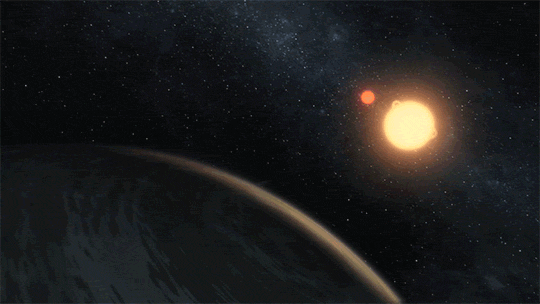
From Luke Skywalker’s home world Tatooine, you can stand in the orange glow of a double sunset. The same could said for Kepler-16b, a cold gas giant roughly the size of Saturn, that orbits two stars. Kepler-16b was the Kepler telescope’s first discovery of a planet in a “circumbinary” orbit (that is, circling both stars, as opposed to just one, in a double star system).
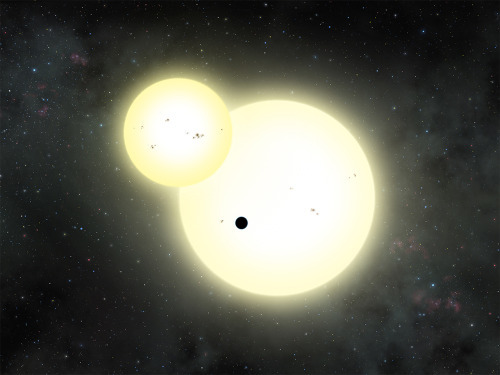
The best part is that Tatooine aka Kepler-16b was just the first. It has family. A LOT of family. Half the stars in our galaxy are pairs, rather than single stars like our sun. If every star has at least one planet, that’s billions of worlds with two suns. Billions! Maybe waiting for life to be found on them.
Desert Worlds

Mars is a cold desert planet in our solar system, and we have plenty of examples of scorching hot planets in our galaxy (like Kepler-10b), which orbits its star in less than a day)! Scientists think that if there are other habitable planets in the galaxy, they’re more likely to be desert planets than ocean worlds. That’s because ocean worlds freeze when they’re too far from their star, or boil off their water if they’re too close, potentially making them unlivable. Perhaps, it’s not so weird that both Luke Skywalker and Rey grew up on planets that look a lot alike.
Ice Planets

An icy super-Earth named OGLE-2005-BLG-390Lb reminded scientists so much of the frozen Rebel base they nicknamed it “Hoth,” after its frozen temperature of minus 364 degrees Fahrenheit. Another Hoth-like planet was discovered in April 2017; an Earth-mass icy world orbiting its star at the same distance as Earth orbits the sun. But its star is so faint, the surface of OGLE-2016-BLG-1195Lb is probably colder than Pluto.
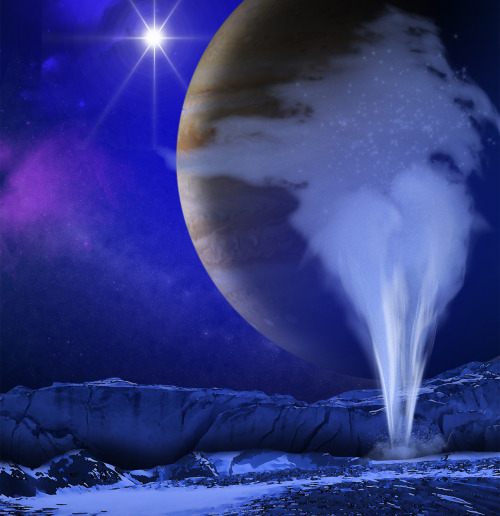
Forest worlds
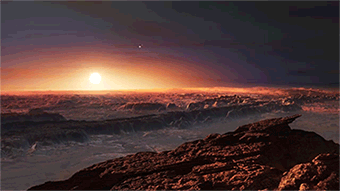
Both the forest moon of Endor and Takodana, the home of Han Solo’s favorite cantina in “Force Awakens,” are green like our home planet. But astrobiologists think that plant life on other worlds could be red, black, or even rainbow-colored!
In February 2017, the Spitzer Space Telescope discovered seven Earth-sized planets in the same system, orbiting the tiny red star TRAPPIST-1.

The light from a red star, also known as an M dwarf, is dim and mostly in the infrared spectrum (as opposed to the visible spectrum we see with our sun). And that could mean plants with wildly different colors than what we’re used to seeing on Earth. Or, it could mean animals that see in the near-infrared.
What About Moons?
youtube
In Star Wars, Endor, the planet with the cute Ewoks, is actually a habitable moon of a gas giant. Now, we’re looking for life on the moons of our own gas giants. Saturn’s moon Enceladus or Jupiter’s moon Europa are ocean worlds that may well support life. Our Cassini spacecraft explored the Saturn system and its moons, before the mission ended in 2017. Watch the video and learn more about the missions’s findings.
And Beyond

The next few years will see the launch of a new generation of spacecraft to search for planets around other stars. Our TESS spacecraft launched in April 2018, and will discover new exoplanets by the end of the year. The James Webb Space Telescope is slated to launch in 2020. That’s one step closer to finding life.

You might want to take our ‘Star Wars: Fact or Fiction?’ quiz. Try it! Based on your score you may obtain the title of Padawan, Jedi Knight, or even Jedi Master!
You don’t need to visit a galaxy far, far away to find wondrous worlds. Just visit this one ... there’s plenty to see.
Discover more about exoplanets here: https://exoplanets.nasa.gov/
Make sure to follow us on Tumblr for your regular dose of space: http://nasa.tumblr.com
#maythe4th#kepler#spitzerspacetelescope#starwars#exoplanets#trappist-1#jameswebbtelescope#tess#cassini#exoplanet#moons#starwarsday
6K notes
·
View notes
Text
Kepler finally ran out of gas, but it will always fuel our planet-hunting ambitions
Kepler finally ran out of gas, but it will always fuel our planet-hunting ambitions
Imagined view from Kepler-10b, a planet that orbits one of the 150,000 stars that the Kepler spacecraft is monitoring.
Number of confirmed exoplanets continues to grow.
Scientists can determine the size or radius of a planet by measuring the depth of the dip in brightness and knowing the size of the star.
Prepping the Kepler spacecraft pre-launch in 2009.
NASA scientists figured out how…
View On WordPress
0 notes
Text
Goodbye Kepler, hello TESS: Passing the baton in the search for distant planets
http://bit.ly/2GHdAqa
Imagined view from Kepler-10b, a planet that orbits one of the 150,000 stars that the Kepler spacecraft is monitoring. NASA/Kepler Mission/Dana Berry, CC BY
For centuries, human beings have wondered about the possibility of other Earths orbiting distant stars. Perhaps some of these alien worlds would harbor strange forms of life or have unique and telling histories or futures. But it was only in 1995 that astronomers spotted the first planets orbiting sunlike stars outside of our solar system.
In the last decade, in particular, the number of planets known to orbit distant stars grew from under 100 to well over 2,000, with another 2,000 likely planets awaiting confirmation. Most of these new discoveries are due to a single endeavor — NASA’s Kepler mission.
Number of confirmed exoplanets continues to grow. NASA/Ames Research Center/Wendy Stenzel and The University of Texas at Austin/Andrew Vanderburg, CC BY
Scientists can determine the size or radius of a planet by measuring the depth of the dip in brightness and knowing the size of the star. NASA Ames, CC BY
Kepler is a spacecraft housing a 1-meter telescope that illuminates a 95 megapixel digital camera the size of a cookie sheet. The instrument detected tiny variations in the brightness of 150,000 distant stars, looking for the telltale sign of a planet blocking a portion of the starlight as it transits across the telescope’s line of sight. It’s so sensitive that it could detect a fly buzzing around a single streetlight in Chicago from an orbit above the Earth. It can see stars shake and vibrate; it can see starspots and flares; and, in favorable situations, it can see planets as small as the moon.
Kepler’s thousands of discoveries revolutionized our understanding of planets and planetary systems. Now, however, the spacecraft is nearly out of its hydrazine fuel and will end its fantastic life sometime in the next few months. Luckily for planet hunters, NASA’s upcoming TESS mission is waiting in the wings and will take over the exoplanet search.
Prepping the Kepler spacecraft pre-launch in 2009. NASA/Tim Jacobs, CC BY
Kepler’s history
The Kepler mission was conceived in the early 1980s by NASA scientist Bill Borucki, with later help from David Koch. At the time, there were no known planets outside of the solar system. Kepler was eventually assembled in the 2000s and launched in March of 2009. I joined the Kepler Science Team in 2008 (as a wide-eyed rookie), eventually co-chairing the group studying the motions of the planets with Jack Lissauer.
Originally, the mission was planned to last for three and a half years with possible extensions for as long as the fuel, or the camera, or the spacecraft lasted. As time passed, portions of the camera began to fail but the mission has persisted. However, in 2013 when two of its four stabilizing gyros (technically “reaction wheels”) stopped, the original Kepler mission effectively ended.
NASA scientists figured out how to use solar pressure to stabilize Kepler. NASA Ames/W Stenzel, CC BY
Even then, with some ingenuity, NASA was able to use reflected light from the Sun to help steer the spacecraft. The mission was rechristened as K2 and continued finding planets for another half decade. Now, with the fuel gauge near empty, the business of planet hunting is winding down and the spacecraft will be left adrift in the solar system. The final catalog of planet candidates from the original mission was completed late last year and the last observations of K2 are wrapping up.
Kepler’s science
Squeezing what knowledge we can from those data will continue for years to come, but what we’ve seen thus far has amazed scientists across the globe.
We have seen some planets that orbit their host stars in only a few hours and are so hot that the surface rock vaporizes and trails behind the planet like a comet tail. Other systems have planets so close together that if you were to stand on the surface of one, the second planet would appear larger than 10 full moons. One system is so packed with planets that eight of them are closer to their star than the Earth is to the Sun. Many have planets, and sometimes multiple planets, orbiting within the habitable zone of their host star, where liquid water may exist on their surfaces.
As with any mission, the Kepler package came with trade-offs. It needed to stare at a single part of the sky, blinking every 30 minutes, for four straight years. In order to study enough stars to make its measurements, the stars had to be quite distant – just as when you stand in the middle of a forest, there are more trees farther from you than right next to you. Distant stars are dim, and their planets are hard to study. Indeed, one challenge for astronomers who want to study the properties of Kepler planets is that Kepler itself is often the best instrument to use. High quality data from ground-based telescopes requires long observations on the largest telescopes – precious resources that limit the number of planets that can be observed.
We now know that there are at least as many planets in the galaxy as there are stars, and many of those planets are quite unlike what we have here in the solar system. Learning the characteristics and personalities of the wide variety of planets requires that astronomers investigate the ones orbiting brighter and closer stars where more instruments and more telescopes can be brought to bear.
Once launched, TESS will identify exoplanets orbiting the brightest stars just outside our solar system. NASA's Goddard Space Flight Center, CC BY
Enter TESS
Duration of TESS’ observations on the celestial sphere, taking into account the overlap between sectors. NASA, CC BY
NASA’s Transiting Exoplanet Survey Satellite mission, led by MIT’s George Ricker, is slated to launch in the next few weeks and will search for planets using the same detection technique that Kepler used. TESS’ orbit, rather than being around the Sun, will have a close relationship with the Moon: TESS will orbit the Earth twice for each lunar orbit. TESS’ observing pattern, rather than staring at a single part of the sky, will scan nearly the entire sky with overlapping fields of view (much like the petals on a flower).
Given what we learned from Kepler, astronomers expect TESS to find thousands more planetary systems. By surveying the whole sky, we will find systems that orbit stars 10 times closer and 100 times brighter than those found by Kepler – opening up new possibilities for measuring planet masses and densities, studying their atmospheres, characterizing their host stars, and establishing the full nature of the systems in which the planets reside. This information, in turn, will tell us more about our own planet’s history, how life may have started, what fates we avoided and what other paths we could have followed.
The quest to find our place in the universe continues as Kepler finishes its leg of the journey and TESS takes the baton.
Jason Steffen receives funding from NASA.
0 notes